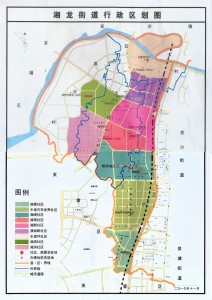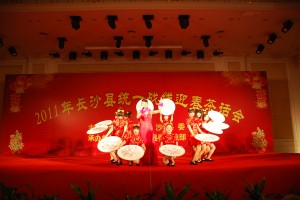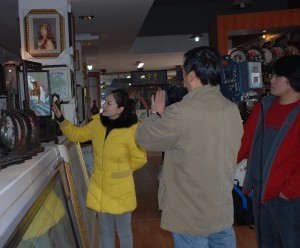据《三湘都市报》4月19日报道:
由湖南省文化厅支持,香港大公报、湖南日报报业集团联合主办的首届湖南省非物质文化遗产系列宣传评选活动对125个候选项目、县市、人物进行公示。如有不同意见,请在4月26日前向宣传评选活动组委会反映。
该活动近日已进入对非物质文化遗产保护工作进行考察采访阶段。湖南省非物质文化遗产保护中心主任刘振平表示,此次是湖南首次举行大规模的非遗保 护宣传评选活动,目的是使非遗保护从少数民间艺人走向大众。
过往很多地方都存在“重申报,轻保护”的现象,我们希望能够通过此行宣传评选活动,能促进各地对非遗项目和保护人物进行合理的规划和保护,活动组委会负责人告诉记者。
此次评选活动分三个大块:
1、十大最具魅力的非物质文化遗产项目(59个)
2、抢救和保护非物质文化遗产项目的“十杰”(25个),其中湘绣城集团总经理曾应明入选为候选名额。
3、保护非物质文化遗产十强县(市、区)(23个)
最后,本次活动评选出18个保护非物质文化遗产特别贡献奖。
湖南非遗125个候选名单出炉——今日起公示 湘绣、浏阳花炮、铜官窑等6项代表长沙入选
“放眼辉煌过去,展望美好未来”— 湘绣城海归学子在2011年长沙市侨界迎春联谊会上之美好愿景
尊敬的各位领导,女士们,先生们,朋友们:
上午好!非常荣幸能有机会参加今天的长沙市侨界迎春联谊会。我们送走了辉煌的2010年,迎来了充满生机的2011年,值此辞旧迎新之际,请允许我代表长沙20万归侨侨眷、海外侨胞,衷心地祝愿大家兔年吉祥,合家欢乐,万事如意!
作为一名归国新侨,我曾先后旅居新西兰、澳大利亚、美国等国多年。每次回国,都见到国内有了日新月异的巨大发展。祖国的日益强大,使我倍感自豪。因此,虽然我已在海外办有公司,获有海外职业资质,也有不少的海外公司邀请我就职,但我仍决定回到家乡来,和我的父辈们一起共同参与湖南湘绣城的建设。我觉得,将自己在海外学习的知识和经验用于家乡的经济建设,亲眼见证祖国走向繁荣富强的过程,对任何一个中华民族的儿女来说,都是一种莫大的荣耀。
在各级领导的关心支持下,2010年湖南湘绣城共接待考察团60余次,接待外商、台商、各级领导及代表2000余人次;成功举办了首届服装博览会、湖南工艺美术精品大奖赛等重大活动;成功举办的首届湘绣文化艺术节暨第三届湖南工艺美术品博览会电视颁奖晚会,并于11月6日在中央7台重点播放; 2010年5月参加第6届深圳文博会,湘绣城的湘绣表演受到了中宣部的表彰和湖南省委宣传部的奖励;湘绣作品《人民的总理》荣获首届中国湘绣艺术节金奖,湘绣作品《和谐盛世》入展上海世博会联合国馆,是湖南省唯一进入联合国展馆的湘绣作品。现在,我们的湘绣产品已成功出口到美国、澳大利亚、俄罗斯、西班牙、意大利等12个国家,每一件产品都成为了宣传中国文化的独特“名片”。2011年,我们还将组织赴日本、韩国、欧美等五国的湘绣作品巡回展出和交流,力争使长沙市的湘绣品牌在世界舞台上全面唱响。我深知,成绩的取得,离不开省市县领导、社会各界的关心和厚爱,借这个机会,我谨代表湖南湘绣城向大家表示衷心的感谢!
回国这些年来,结合我的亲眼所见,亲耳所闻,我还有一个特殊的感受,觉得长沙市侨办、市侨联对我们这些侨企非常重视,不仅坚持深入企业,倾听大家的意见和建议,而且积极地为企业排忧解难,支持企业做大做强,无微不至的关怀常常让我备受鼓舞,非常感动。
大河有水,小河满。正是有了诸多这样的大力支持,我市的侨资企业也获得了快速的发展。
各位领导,女士们,先生们,朋友们,回顾过去,我们倍感欣慰;展望未来,我们豪情满怀。在新的一年里,恭祝各位领导,各位朋友春节快乐,工作顺利!让我们携起手来,在长沙这块宝地创业,兴业,共同谱写2011年新的辉煌!
谢谢大家!
湖南湘绣城 曾理
湘绣领军人曾应明:开卷总有益,留心皆学问
曾应明说平时读书积累的知识,在和外国客人谈生意时,也很有用。图为他考察澳大利亚刺绣工艺品市场。
曾应明从事刺绣开发研究30余年,不仅在湘绣技艺上屡创新高,更是“工艺湘军”企业群的倡导者,他开创了 湘绣的产业化发展模式,特别是在民间文化产业的国际化发展道路上,由他担任总经理的湖南湘绣城年创外汇在2008年时就达到5亿元,上缴利税近3000万 元,解决了几千人的就业问题……然而很少有人知道,这位“工艺湘军”的领军人之一,在青年时代差点成了“文艺小青年”,而对于读书的痴狂和坚持,让他在工 作和生活中,受益不尽。
他的读书故事
一本《共产党宣言》他倒背如流
出生于上世纪50年代的曾应明坦言,自己在校园里读书的时间不多,“初中到高中,总共读了8年。”但是当 年的他只要能拿到手的书,都必定认真读完。“还记得高二时参加作文比赛获奖,奖品是《共产党宣言》,我把它塞在书包里,每天都看,最后整本书都能背下来 了。”读中学时,家里只有煤油灯照明,夏天在蚊帐里读书的他,几次因为读书至深夜,烧掉了蚊帐,有一次还差点把整个床头都烧着了。
“对我影响最深刻的书是《钢铁是怎样炼成的》。”说到这里,曾应明现场背诵起来其中的经典句子:“人最宝贵的是生命。生命属于人只有一次。人的一生应该是这样度过的:当他回首往事的时候,不会因为虚度年华而悔恨,也不会因为碌碌无为而羞耻……”
正是因为不想“碌碌无为”,曾应明在1975年因爱好绘画进入湘绣厂工作,第一个月的工资全部用来订阅了 《人民文学》、《诗刊》、《散文》等书刊杂志,并频频投稿,曾应明笑称自己当时就是个“文艺小青年”。自1977年首次在杂志上发表文章,他已在全国20 多种刊物上发表100多万字作品。
深知图书对于文化传承作用的曾应明创作过故事集《湘绣传说故事》、《手工艺大市场——湘绣走向世界的启 示》两部作品,将百幅经典湘绣背后的故事以及湘绣行业发展历史和走向都记录于书中。他说关于湘绣历史的小说《守望百年》和关于湘绣技艺的《湘绣基本知识》 正在创作当中。反映湘绣百年历史的120万字长篇小说《守望百年》已完工三分之一,这个大部头的作品将拍成35集电视连续剧,从电视剧主题曲作词,到角色 选择,曾应明都亲力亲为。
他的读书心得
读书,处处有用
曾应明说,工作再繁忙,也要拿出时间来读书。“我现在只要坐在车上,不看书就会有失落感。读书是休闲,因 此不会觉得辛苦。”而平时读书储备的知识,对于工作有潜移默化却又是重大的帮助。他自豪地说起了一次去台湾交流经验的故事。“我们一行人到新竹县进行普通 的交流活动,和新竹县长聊天时,聊到县长取消了和别人的晚餐,和我们聊到深夜2点,还聊下来一个大订单。”他说新竹县不仅委托他的公司制作官方伴手礼,还 聘请他做“县政顾问”,“如果不是平时看书学习的积累,根本做不到。因此我一直坚信,开卷有益,10万字的书中,有一句对你产生影响,这书就值得去读。”
2011愚人节之“愉”闻愚录
1、前面也有雨
有个男人在雨里慢慢行走。路上有人见了觉得奇怪,问他道:
“雨下得这么大,你怎么不快点走?”
他从从容容地答道:“快点儿走有啥用?前面也有雨嘛!”
2、黄瓜失恋痛哭,茄子安慰她:爱情不单只是甜美、只是沉醉,还有心碎、还有流泪。唉!谁让你爱上洋葱的?
3、找钱
有一天,一个人在沙漠里挖坑。有个过路的人见了,问他挖什么,他说:“我在沙漠里埋了一些钱,现在找不到埋的地方了。” 那人说:“你埋钱的时候应当做个标记呀!”
“我做了标记。”
“什么标记?”
他说:“当时天上的乌云正遮着它。”
4、幸亏它帮忙
有个男人上街买了一担米,一头重,一头轻,不好挑。他抓抓头皮想出了一个办法,在轻的一边放上一块大石头。他汗流泱背地把米挑到家,放下担子,长长嘘了一口气道:“今天幸亏有这块石头, 不然简直没办法挑回来!”
今天又有多少人被愚弄得”愉“快了呢?有木有?有木有?····
新华网海外版:《中国必需促进文化产业发展》
China must promote its cultural industry
BEIJING, Dec. 12 — Judging from the rules and trends of social economic development, the cultural industry shows the biggest potential in the 21st century.
The Intergovernmental Conference on Cultural Policies for Development was held in Stockholm in 1998 and the Action Plan on Cultural Policies for Development was approved. The plan recognizes the principle that development can be ultimately defined in cultural terms and the flourishing of culture is the highest end of development.
The changes in the international economic structure accurately reflect the rapid advancement of social productivity. Especially since the 1980s, the world’s economy has achieved essential transitions almost every decade. The economy focused on manufacturing in the 1980s while the service and telecommunication industries gained rapid growth in the 1990s. The 21st century, no doubt, belongs to the cultural industry.
The emergence and boom of the knowledge industry has led to the creation of the quaternary industry theory, which further divides intellectual work from physical labor. Industries based on brainwork or knowledge are called the quaternary industry. And thus the concept of the cultural industry emerged and gradually matured.
In the 40 years since the theory of the quaternary industry came into being to the end of the last century, the United States had experienced three major adjustments to its industrial structure, enhancing the cultural industry each time. Leaving all other countries far behind, the US became a cultural industry superpower.
Chinese scholars became aware of the cultural industry theory only less than two decades ago. Until today it is difficult to say whether we have really changed our traditional mode of thinking and realize the significance of the cultural industry.
The industry is the one responsible for the production and marketing of cultural products with creative ideas as its core. China formally defined in 2004 the concept of the industry as a collection of activities to provide the public with cultural and entertainment products and services.
It is noteworthy that there are always disputes about how to define the cultural industry or the creative industry in the international community. But consensus has been reached on the significance and vital status of the cultural industry in the process of economic globalization in the 21st century.
Statistics by the United Nations show that the growth rate of the global market on the whole is about 3 percent while that of the cultural industry is 6 percent. The cultural industry based on knowledge and creativity features relatively low input but high added value and efficiency compared with traditional industries. It also has strong sustainability with low resource consumption and little damage to the environment.
Overall, as humans solve the problems of food and other basic necessities as their incomes increase, the cultural industry has become a promising sector that fits people’s spiritual needs. It is a general trend for international communities to develop their cultural industries.
The cultural industry in the US contributes about a quarter of the country’s total GDP, second only to its war industry. New York city alone makes $20 billion out of the cultural industry annually. The first two installments of the Godfather movie series alone earned more than $800 million at the international box-office, which allows us to realize that movies are the biggest factories. The movie, Titanic, surpassed $1.8 billion in global box-office receipts and produced another $1.8 billion in revenue from spin-offs. Just calculate how much resources and labor we will need to produce $3.6 billion worth of clothes or furniture.
Japan comes after the US with its cultural industry surpassing its electronic and auto industries. The Japanese animation industry occupies 62 percent of the world’s market and its games industry has one-third of the market share. The Republic of Korea made it a national policy to develop its cultural industry in 1998 and then targeted the Chinese market. It once occupied 75 percent of China’s games market. These numbers are really alarming.
The Chinese cultural industry is facing a grave situation in such a world trend. China’s cultural industry only comprises about 3 percent of the country’s GDP. As Chinese people’s cultural demands increase with rising incomes the cultural products we supply do not meet market demand.
Against the backdrop of continuous trade surpluses, the cultural industry faces a drastic imbalance. Take the book trade for example, China’s ratio with the West is 1:100. More than 285 Russian artistic groups performed in China from 1999 to 2002 while only 30 Chinese groups went to Russia.
From 2000 to 2004 China imported 4,332 movies while less than 100 were exported. This is an embarrassing fact for a country with more than 5,000 years of history, culture and civilization.
The competition in the international cultural industry will further intensify. We do not have a choice, we must be able to compete. A country without modern cultural accomplishments and influences will not be respected, no matter how vigorous its economy is.
We have to update our economic thinking and be vigilant against the lopsided concept that stresses economic growth while paying little regard to the cultural industry.
首届中国湘绣文化艺术节暨湖南省第三届工艺美术品博览会电视颁奖晚会-湘绣歌曲视频欣赏
首届中国湘绣文化艺术节暨湖南省第三届工艺美术品博览会电视颁奖晚会,现场表演的湘绣原创歌舞蹈表演欣赏:
《百年守望》
《绣遍天涯竞风流》





